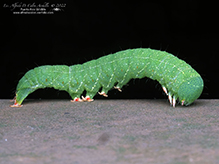brown panopoda moth
(Panopoda carneicosta)
Conservation • Description • Habitat • Ecology • Distribution • Taxonomy
|
||||||||
| Hodges # | 8588 |
|||||||
Conservation Status |
||||||||
| IUCN Red List | not listed |
|||||||
| NatureServe | NNR - Unranked SNR - Unranked |
|||||||
| Minnesota | not listed |
|||||||
Description |
||
Brown panopoda moth is a common, triangular, woodland moth. It occurs in the United States east of the Great Plains. It is common in the eastern half of the country, uncommon in Minnesota, where it reaches the northwestern extent of its range. The larvae feed on the leaves of hickory trees. Reports of them feeding on oak, willow, and basswood are questionable. Adults are found from June to August in deciduous woodlands. Adults are 13⁄16″ to 1″ (21 to 25 mm) in length and have a 1½″ to 1 13⁄16″ (38 to 46 mm) wingspan. The forewings are grayish brown with a violet gray tint. There is dark, diffuse shading in the subterminal and terminal areas except at the wingtip. The antemedial (AM) and postmedial (PM) lines are thin, slightly wavy, brown, and edged with yellow. The median line is thicker but diffuse, often incomplete, and sometimes indistinct. It usually has dark shading below. There is a small spot (orbicular spot) in the upper median area and a large spot (reniform spot) in the lower median area. The orbicular spot is a black dot. The reniform spot is black and L shaped. It is sometimes reduced or even absent. The hindwing is yellowish brown. |
||
Size |
||
Total length: 13⁄16″ to 1″ (21 to 25 mm) Wingspan: 1½″ to 1 13⁄16″ (38 to 46 mm) |
||
Similar Species |
||
Habitat |
||
Deciduous woodlands |
||
Ecology |
||
Season |
||
One generation per year: June to August |
||
Behavior |
||
Adults are active at night and will come to lights. |
||
Life Cycle |
||
|
||
Larva Food |
||
Leaves of hickory trees |
||
Adult Food |
||
Flower nectar |
||
Distribution |
||||
|
Sources |
|||
| 12/6/2023 | ||||
Occurrence |
||||
Uncommon in Minnesota |
||||
Taxonomy |
|||
Order |
Lepidoptera (Butterflies and Moths) | ||
Superfamily |
Noctuoidea (Owlet Moths and Allies) | ||
Family |
Erebidae (Underwing, Tiger, Tussock, and Allied Moths) | ||
Subfamily |
Eulepidotinae | ||
Tribe |
Panopodini | ||
Genus |
Panopoda (panopoda moths) | ||
Synonyms |
|||
Ophiusa combinata Poaphila scissa |
|||
Common Names |
|||
brown panopoda brown panopoda moth |
|||
Glossary
Antemedial (AM) line
A thin line separating the basal area and the median area of the forewing of Lepidoptera.
Orbicular spot
A circular spot or outline in the upper median area near the antemedial line on the forewing of many moths.
Postmedial (PM) line
A thin line separating the median area and the postmedial area of the forewing of Lepidoptera.
Reniform spot
A kidney-shaped spot or outline in the lower median area near the PM line on the forewing of many moths.
Visitor Photos |
|||||
Share your photo of this insect. |
|||||
| This button not working for you? Simply email us at info@MinnesotaSeasons.com. Attach one or more photos and, if you like, a caption. |
|||||
Alfredo Colon |
|||||
 |
 |
||||
MinnesotaSeasons.com Photos |
|||||
|
|||||

Slideshows |
||

Visitor Videos |
|||
Share your video of this insect. |
|||
| This button not working for you? Simply email us at info@MinnesotaSeasons.com. Attach a video, a YouTube link, or a cloud storage link. |
|||
Other Videos |
|||

Created: 12/6/2023
Last Updated:


